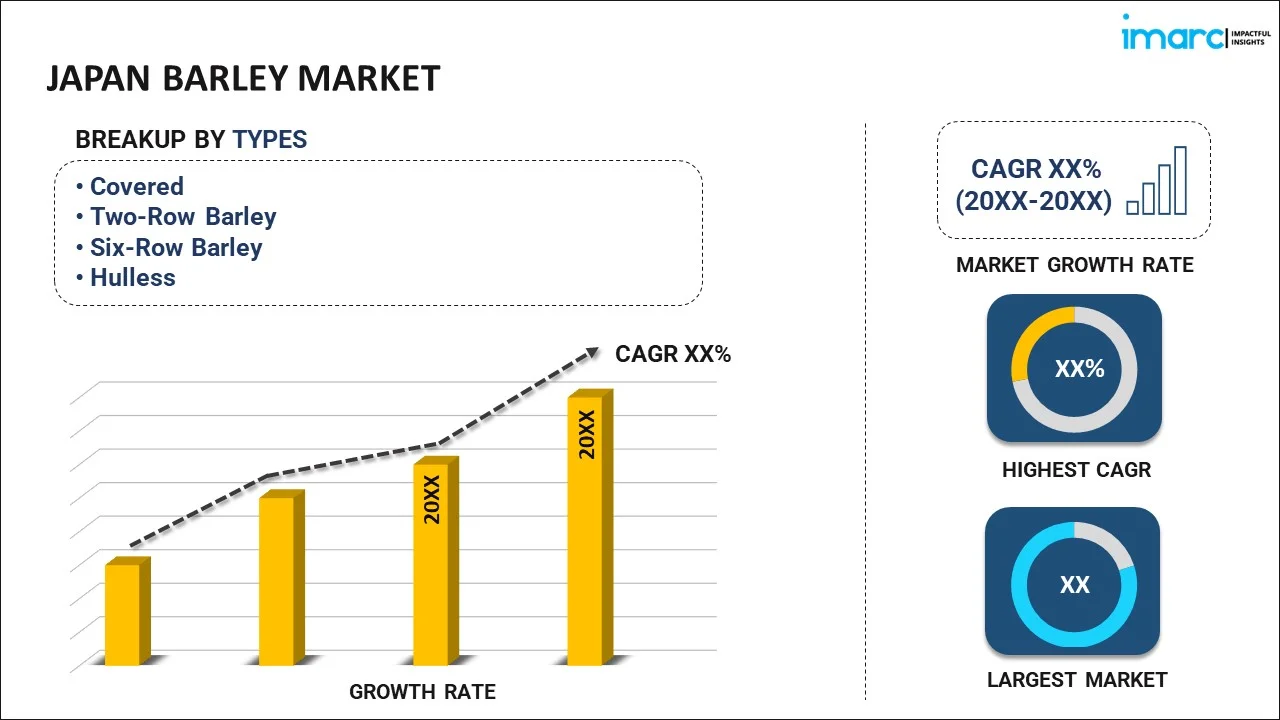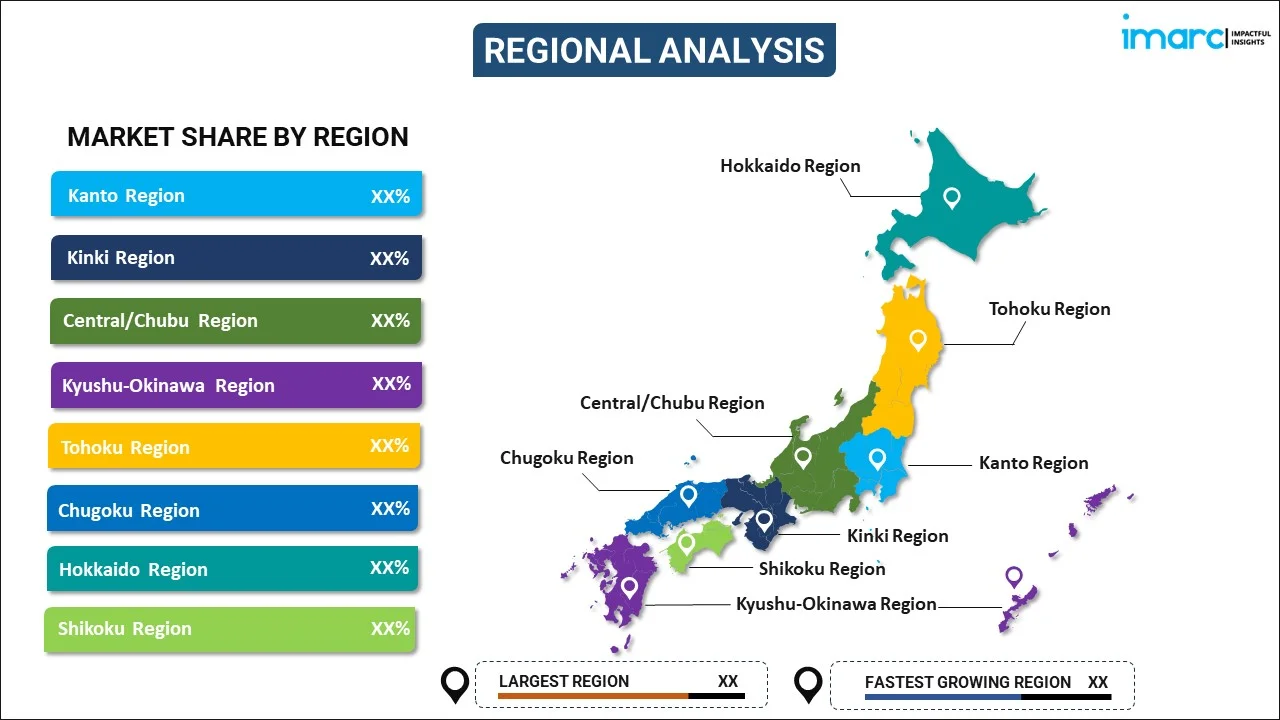
Japan Barley Market Report by Type (Covered, Two-Row Barley, Six-Row Barley, Hulless), Grade (Food Grade, Feed Grade, Malt Grade), Distribution Channel (Supermarkets and Hypermarkets, Departmental Stores, Specialty Stores, Online Stores), Industry Vertical (Food and Beverages, Pharmaceuticals, Seed Industry, Personal Care, Animal Feed, Nutraceuticals, and Others), and Region 2025-2033
Market Overview:
The Japan barley market size reached 220 Thousand Tons in 2024. Looking forward, IMARC Group expects the market to reach 301.4 Thousand Tons by 2033, exhibiting a growth rate (CAGR) of 3.2% during 2025-2033. The growing health consciousness among consumers and the collaborations between food companies and hospitality businesses, along with the expansion in the food and beverage (F&B) and agriculture industries represent some of the key factors driving the market.
|
Report Attribute
|
Key Statistics
|
|---|---|
|
Base Year
|
2024 |
|
Forecast Years
|
2025-2033
|
|
Historical Years
|
2019-2024
|
| Market Size in 2024 | 220 Thousand Tons |
| Market Forecast in 2033 | 301.4 Thousand Tons |
| Market Growth Rate (2025-2033) | 3.2% |
Barley is a multipurpose grain, mainly utilized in bread, drinks, and diverse dishes globally. Barley, with the scientific name Hordeum vulgare, belongs to the grass family and is one of the key cereal grains. It is a yearly plant that develops from seeds and achieves maturity in approximately two to three months. Its seeds are covered by a hard, non-consumable shell. The hue of barley grains ranges from yellow to purple, influenced by the cultivar. It is recognized for its robust characteristics, which are able to endure an array of climate types, ranging from the chilly areas of the highlands to the warm climates of the tropics. A remarkable characteristic of barley is its abundant nutritional content. It is rich in fiber, vitamins, and minerals, such as magnesium and selenium. Barley offers a unique, mildly nutty taste and chewy consistency that can elevate numerous recipes. It serves as a main component in many food items and drinks, especially bread and beer. The grain's capacity to take in flavors renders it a flexible component in salads, soups, and stews. Barley is known for its ability to produce malt, playing a crucial role in the brewing sector.
Japan Barley Market Trends:
The growing health consciousness represents one of the key factors stimulating the growth of the barley market in Japan. In addition to this, the rising prices of alternative grains are making barley an economically attractive option, thereby spurring the market growth. Moreover, the availability of diverse barley varieties and products is expanding consumer choices and propelling the market. Besides this, advancements in agricultural techniques are leading to increased barley yield, making it more available in the market. Additionally, favorable government initiatives are encouraging local farmers to cultivate more barley. The robust supply chain across the country ensures the freshness and quality of barley, thereby supporting the market growth. Collaborations between food companies and hospitality businesses are facilitating the promotion and inclusion of barley-based dishes and beverages in menus. The increasing consumer inclination toward diverse and health-oriented dietary options are contributing to the barley market growth in Japan. The growing trend of online food ordering and delivery services is leading to a surge in demand for barley products. Coupled with this, the rising digitalization and rising online grocery shopping trend are further driving the growth of the barley market in Japan. Other factors, such as high disposable income, the development of the tourism industry, and the growing popularity of traditional cuisines in Japan, many of which use barley as a key ingredient, are propelling the market growth across the country.
Japan Barley Market Segmentation:
IMARC Group provides an analysis of the key trends in each segment of the Japan barley market report, along with forecasts at the country level for 2025-2033. Our report has categorized the market based on type, grade, distribution channel, industry vertical.
Type Insights:

- Covered
- Two-Row Barley
- Six-Row Barley
- Hulless
The report has provided a detailed breakup and analysis of the market based on the type. This includes covered, two-row barley, six row barley, and hulless.
Grade Insights:
- Food Grade
- Feed Grade
- Malt Grade
The report has provided a detailed breakup and analysis of the market based on the grade. This includes food grade, feed grade and malt grade.
Distribution Channel Insights:
- Supermarkets and Hypermarkets
- Departmental Stores
- Specialty Stores
- Online Stores
The report has provided a detailed breakup and analysis of the market based on the distribution channel. This includes supermarkets and hypermarkets, departmental stores, specialty stores and online stores.
Industry Vertical Insights:
- Food and Beverages
- Pharmaceuticals
- Seed Industry
- Personal Care
- Animal Feed
- Nutraceuticals
- Others
The report has provided a detailed breakup and analysis of the market based on the industry vertical. This includes food and beverages, pharmaceuticals, seed industry, personal care, animal feed, nutraceuticals and others.
Regional Insights:

- Kanto Region
- Kinki Region
- Central/Chubu Region
- Kyushu-Okinawa Region
- Tohoku Region
- Chugoku Region
- Hokkaido Region
- Shikoku Region
The report has provided a detailed breakup and analysis of the market based on the region. This includes Kanto region, Kinki region, Central/Chubu region, Kyushu-Okinawa region, Tohoku region, Chugoku region, Hokkaido region and Shikoku region.
Competitive Landscape:
The report has also provided a comprehensive analysis of the competitive landscape in the Japan barley market. Competitive analysis, such as market structure, key player positioning, top winning strategies, competitive dashboard, and company evaluation quadrant has been covered in the report.
Japan Barley Market News:
- In April 2025, ITOCHU Corporation announced a strategic partnership with The Healthy Grain to acquire the trademark and exclusive marketing rights for BARLEYMAX® Super Barley™ in Japan and Taiwan, effective May 2025. This move supports ITOCHU’s strategy to expand in consumer-focused health food markets.
- In February 2025, Otsuka Foods announced the launch of “Mannan Gohan with Glutinous Barley and Brown Rice,” a packaged rice product under its Mannanhikari brand. The product also contains 25% fewer carbs and calories than white rice.
- In February 2025, the Los Angeles Dodgers partnered with Nikaido Shuzou Co., Ltd., naming it the Official Shochu of the team. Nikaido, known for pioneering 100% barley (mugi) shochu, will offer its barley-based spirit at Dodger Stadium in drinks like the NIKASO™ highball.
Japan Barley Market Report Coverage:
| Report Features | Details |
|---|---|
| Base Year of the Analysis | 2024 |
| Historical Period | 2019-2024 |
| Forecast Period | 2025-2033 |
| Units | 000 Tons |
| Scope of the Report | Exploration of Historical and Forecast Trends, Industry Catalysts and Challenges, Segment-Wise Historical and Predictive Market Assessment:
|
| Types Covered | Covered, Two-Row Barley, Six-Row Barley, Hulless |
| Grades Covered | Food Grade, Feed Grade, Malt Grade |
| Distribution Channels Covered | Supermarkets and Hypermarkets, Departmental Stores, Specialty Stores, Online Stores |
| Industry Verticals Covered | Food and Beverages, Pharmaceuticals, Seed Industry, Personal Care, Animal Feed, Nutraceuticals, Others |
| Regions Covered | Kanto Region, Kinki Region, Central/Chubu Region, Kyushu/Okinawa Region, Tohoku Region, Chugoku Region, Hokkaido Region, Shikoku Region. |
| Customization Scope | 10% Free Customization |
| Post-Sale Analyst Support | 10-12 Weeks |
| Delivery Format | PDF and Excel through Email (We can also provide the editable version of the report in PPT/Word format on special request) |
Key Benefits for Stakeholders:
- IMARC’s report offers a comprehensive quantitative analysis of various market segments, historical and current market trends, market forecasts, and dynamics of the Japan barley market from 2019-2033.
- The research study provides the latest information on the market drivers, challenges, and opportunities in the Japan barley market.
- Porter's five forces analysis assist stakeholders in assessing the impact of new entrants, competitive rivalry, supplier power, buyer power, and the threat of substitution. It helps stakeholders to analyze the level of competition within the Japan barley industry and its attractiveness.
- Competitive landscape allows stakeholders to understand their competitive environment and provides an insight into the current positions of key players in the market.
Key Questions Answered in This Report
The barley market in Japan reached 220 Thousand Tons in 2024.
The Japan barley market is projected to exhibit a CAGR of 3.2% during 2025-2033, reaching 301.4 Thousand Tons by 2033.
The barley market in Japan is influenced by shifting consumer preferences toward health-conscious diets, increased demand for functional foods, and changing agricultural policies. Additionally, innovation in food processing and evolving beverage trends contribute to the market growth, while sustainability concerns drive interest in locally sourced and eco-friendly barley.
Need more help?
- Speak to our experienced analysts for insights on the current market scenarios.
- Include additional segments and countries to customize the report as per your requirement.
- Gain an unparalleled competitive advantage in your domain by understanding how to utilize the report and positively impacting your operations and revenue.
- For further assistance, please connect with our analysts.
 Request Customization
Request Customization
 Speak to an Analyst
Speak to an Analyst
 Request Brochure
Request Brochure
 Inquire Before Buying
Inquire Before Buying




.webp)




.webp)












